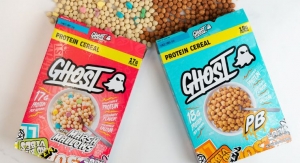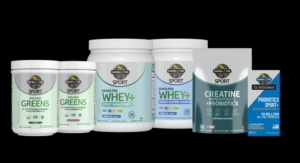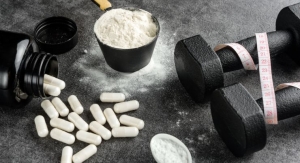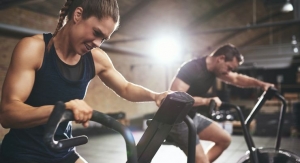By Lisa Olivo, Associate Editor11.01.17
Supplements in various forms are fueling athletes, exercise enthusiasts, active seniors, and weekend warriors in achieving their health and fitness goals. The U.S. represents the largest market for sports nutrition supplements, according to Euromonitor International, growing by 12% in 2016 thanks in large part to a continued expansion of the category’s demographic base.
“Sports nutrition is the fastest growing category within consumer health,” observed Missy Lowery, head of integrated marketing, Capsugel, Morristown, NJ, now a Lonza company. She noted that in 2011 the category earned $7.3 billion, and climbed to an impressive $11.9 billion in 2016, according to Euromonitor. It’s expected to continue developing at this pace from 2016-2021, with a forecast CAGR of 7.9%. “The reason? Mainstream consumers are flooding into the pool,” Ms. Lowery noted.
Where hardcore athletes and bodybuilders once dominated the market for sports nutrition, a broader range of consumers are now participating in the category.
“Today, there is no typical sports nutrition consumer,” Ms. Lowery commented. “Marketers say it is quickly evolving into an active nutrition market fueled by healthy living and fitness trends, as well as seniors bent on maintaining mobility and independence.”
Younger consumers and millennials are also transforming the marketplace by demanding high quality, clean label products. “The on-the-go demand and lifestyle users who are young and affluent—but unwilling to sacrifice the health and wellness claims such as organic, natural, sustainable, vegan, and non-GMO, even in their sports nutrition products—have generated interest in new clean label, non-animal products as well as ready-to-drink beverages and protein bars,” said Ms. Lowery.
Top concerns for this newly emerging audience focuses on energy and endurance, weight loss, performance, recovery, and overall wellness, she added. Leading manufacturers and suppliers within the industry are stepping up to satisfy the evolving needs of the new sports nutrition consumer.
Emerging Participants
Mounting consumer interest in health and wellness is spurring growth within the nutraceuticals category as a whole. Likewise, this health-minded group is prioritizing an active lifestyle, and turning to supplements to fuel their training and fitness efforts.
The rise in popularity of activities such as high-intensity interval training, CrossFit, and obstacle racing are introducing more consumers to sports supplements, according to Tim Hammond, vice president of sales & marketing, Bergstrom Nutrition, Vancouver, WA. He believes these consumers—often referred to as “weekend warriors”—are much more than casual participants. “The focus, skill, and physicality necessary to compete in these ‘sports-fitness’ crossovers—along with the high participation of female athletes—opens up new marketing and formulation opportunities way beyond just fueling.”
Karen A. Hecht, PhD, scientific affairs manager for AstaReal USA Inc., Bellevue, WA, also pointed to participation among female athletes as an emerging demographic. “Women comprise another rapidly growing consumer group as well as more middle-aged and senior consumers.” She added that senior consumers have begun to show a greater interest in taking sports nutrition products to help maintain muscle mass. “Because of this, many sports nutrition companies are launching products in various delivery formats and expanding distribution via mass channels.”
Those interested in aging gracefully are a key group propelling growth in the category, explained Larry Kolb, president of TSI USA, Inc., Missoula, MT. This older set is looking to avoid injury, preserve mobility, while feeling youthful and staying active, he said. “Gracefully aging consumers are staying active, and tend to think of themselves as a decade younger than they are. They’re men and women, 55 and older. These consumers are familiar with bone and joint health and want to slow the process of muscle, strength, and mobility loss. Their main concern isn’t improving appearance or losing weight, it’s quality of life.”
He added that age-related loss of muscle mass, also called sarcopenia, is one of the greatest long-term health issues for this group, posing a serious threat to health and the ability to function independently. “It is common to lose 35-40% of muscle mass and 20-40% of muscle strength between the ages of 20 and 80 years. Sarcopenia begins in the 30s, and the rate of decline increases with age.” He pointed to decreased physical activity leading to muscle atrophy and loss of appetite resulting in insufficient nutrient intake as contributors to strength and muscle mass loss.
Other consumers, are “actively tuned-in,” and see exercise and fitness as a way of life, noted Mr. Kolb. These consumers “want to feel good, look good, and enjoy long-term health,” he said. “The actively tuned-in consumer is serious about fitness and nutrition as a way to create the life they want.” This group is between the ages of 25 and 49, middle to high income, and roughly 55% female. “They’re active, they’re well informed, they’re bringing smoothies to work. You’ll find them doing yoga or Pilates, cycling, running, hiking, or competing in triathlons. Their goal is to keep their active lifestyle as long as possible.”
Performance & Endurance
Performance-driven consumers are yet another segment propelling the sports nutrition category, Mr. Kolb indicated. Theses consumers are often young, motivated, and very competitive. “They’re looking to maximize their power, energy and performance to get an edge. They’re mostly men, ages 20 to 35. They’re looking for a competitive edge that allows them to train harder, more often, and with noticeably better results.”
To meet the needs of these performance driven consumers, numerous scientifically validated ingredients are offering the critical support needed in order to train harder, and see better results.
A mainstay in the performance sector, protein products are popular among numerous, and varying demographics. Heather Arment, marketing coordinator. North America, for GELITA USA, Sergeant Bluff, IA, suggested protein products account for the vast majority of sales, calling it “the quintessential nutrient for athletes, weekend warriors, and active people who want to maximize the impact of their training sessions.” Collagen, she said, is one protein in particular that can benefit users, as it is a main structural component in various human tissues. “Collagen is the most abundant protein in the human body, comprising about 30% of total protein content and is an important protein source, providing the nutrients required for the many processes that take place in muscles and cells.”
To help consumers retain an optimal body composition and to support an active lifestyle, GELITA developed the ingredient BODYBALANCE. “These highly specialized collagen peptides have been shown to decrease fat mass, increase lean body mass, and to provide more muscle strength in combination with resistance training. Muscles are essential for physical activity, stability and posture; they enable blood circulation and help during the digestion of food. A loss of muscle mass over the course of a lifetime means a loss of mobility, which is followed by a loss of independence and a loss of quality of life.”
She referenced several randomized, placebo-controlled, double-blinded studies that have demonstrated the efficacy of daily intake of 15 grams of BODYBALANCE in combination with resistance training. “In the latest study (Zdzieblik, D. et al. British Journal of Nutrition, 2015), the effect of post-exercise supplementation on lean body mass, fat mass, and muscle strength in combination with resistance training was tested. One hundred fourteen healthy, physically inactive men, aged 35-60 participated. The results of the primary endpoint of the study revealed a statistically significant increase in lean body mass after BODYBALANCE supplementation compared to placebo. BODYBALANCE supplementation led to improved muscle strength, a reduction of waist circumference, and a statistically significant fat mass reduction after collagen peptide intake.”
Rembrandt Foods, Spirit Lake, IA, also offers unique protein ingredients. Eggs, the company said, offer a recognizable, clean label ingredient that packs a nutritional punch; one whole egg provides 6 grams of protein with only 70 calories. Adding to their benefits, eggs provide all nine essential amino acids (EAA) as well as nine non-essential amino acids, which are necessary for muscle protein synthesis. Rembrandt Foods offers REMPRO, an egg white high protein product, available in an instant egg white protein or as an egg white protein isolate. The company suggested REMPRO is ideal for nutritional beverages and protein-fortified foods such as bars, food mixes, and other snacks.
Lynda Doyle, senior vice president, global marketing for OmniActive Health Technologies, Morristown, NJ, pointed to the benefits of the company’s ingredient Lutemax 2020 in providing support for eye and brain function, which are both critical to performance on and off the field. “Lutemax 2020 provides all three macular carotenoids—lutein and enhanced levels of zeaxanthin isomers [RR- and RS (meso)-zeaxanthin] in a single, convenient ingredient. LAMA I & II (Lutein, Vision and Mental Acuity) studies demonstrated Lutemax 2020 significantly supported measures of visual performance and healthy brain function—for example increased neural and visual processing speed—in young adults, both key benefits for any premium sports nutrition product.”
Additionally, OmniActive’s CurcuWIN curcumin with enhanced absorption delivers the sports nutrition benefits of turmeric. Ms. Doyle pointed to the FloMeD (Flow Mediated Dilation and Curcumin) study, which demonstrated that long term supplementation with CurcuWIN helped support healthy blood flow and circulation, which are important to sports performance and staying active. “OmniActive Health Technologies has been granted a U.S. patent for the highly bioavailable, clinically-studied UltraSOL line of curcumin ingredients, including CurcuWIN, for their sports nutrition and performance benefits,” she explained. “The patent covers these proprietary ingredients’ compositions for improving muscle performance, endurance capacity and resistance to fatigue when administered in effective amounts in humans undergoing exercise.” She added that curcumin also offers support for normal, healthy inflammatory response post-exercise.
Furthermore, science around ginger has demonstrated its antioxidant and anti-inflammatory activity, which are both crucial in sports performance and recovery, according to Ms. Doyle. “Manufactured using a CO2 supercritical extraction process without the use of harsh solvents, Gingever delivers a minimum of 30% bioactives (25% gingerols) delivering a potent boost of ginger to any sports nutrition formulation.”
Tongkat Ali root extract, sold under the name LJ100, is the only ingredient of its kind clinically proven to benefit sport nutrition, commented Annie Eng, CEO, HP Ingredients, Bradenton, FL. Concentrated into a 100:1 water extract standardized to 40% glycosaponins, and greater than 22% eurypeptides, LJ100 has been found to create a favorable anabolic state, while suppressing a catabolic state, thus enhancing performance. Additionally, LJ100 supplementation has been shown to increase fat free mass and decrease body fat, and increase muscle strength and size, as well as endurance.
Citing clinical research, Ms. Eng said, “One placebo-controlled endurance study published in Society of Sport Medicine (2006) looked at how 100 mg LJ100 affected 30 men recruited to engage in a 24-hour mountain biking event. The volunteers completed four approximately 15-mile laps (total 60 miles) and provided eight saliva samples during the test period. The LJ100 group took the supplement 30 minutes prior to endurance exercise. At the end of the study, cortisol levels were 32.3% lower in the LJ100 group compared to placebo, and testosterone levels were 16.4% higher in the LJ100 group compared to placebo; this is a significant rise in a short time. The authors concluded that LJ100, through its apparent ability to maintain low-normal levels of cortisol and high-normal levels of testosterone, improved anabolic state during intense endurance workouts.” Further research of LJ100 demonstrated benefits for strength and muscle quality in middle-aged women.
AstaReal astaxanthin has been found to support exercise endurance and muscle recovery. The company’s Dr. Hecht explained that AstaReal is a natural antioxidant derived from the algae Haematococcus pluvialis, which acts as a mitochondrial nutrient, helping to protect this energy-producing organelle from free radicals produced during exercise. “By neutralizing free radicals produced at high levels during exercise, AstaReal astaxanthin has been shown to protect the skeletal muscle from the oxidative damage generated by physical activity,” she said. “Furthermore, astaxanthin improves the metabolism of lipids as a source of energy production by protecting carnitine palmitoyltransferase I (CPT I) involved in fatty acid transport into mitochondria. This means that athletes can get more sustained energy from fat and maintain muscle glycogen energy reserves for longer (Aoi et al.). By reducing reliance on sugars for energy, athletes supplementing with AstaReal astaxanthin are able to reduce the lactic acid buildup that contributes to delayed onset muscle soreness (Sawaki et al.).”
Demonstrating the ingredient’s benefits for endurance, Dr. Hecht referenced a randomized, double-blind, placebo controlled study published in Carotenoid Science in 2008, which found those supplemented with AstaReal had better results from training over time. Healthy male paramedic students undergoing strength and endurance training, which included standardized exercise tests consisting of 94-pound Smith machine squats, were supplemented with 4 mg AstaReal astaxanthin per day for six months. Those given the supplement performed better after the 6-month supplementation and training period compared to the placebo group. “There was a statistically significant difference at 6 months with placebo group improving by nine squats and AstaReal astaxanthin group improving by 27 squats,” noted Dr. Hecht.
Natreon, New Brunswick, NJ, recently premiered it Natreon One sports nutrition platform, with the goal of providing formulators and brand owners with ingredient solutions that achieve consumers’ preference for natural and scientifically studied ingredients. Offerings of the lineup include the endurance ingredient Capros, a heart-healthy Phyllanthus emblica extract that boosts nitric oxide levels and supports healthy blood flow, significantly reduces hsCRP which leads to decreased inflammation and better recovery, and acts as an antioxidant to protect the body against oxidative stress. To boost focus, Natreon provides Sensoril, a standardized aqueous botanical extract of Ashwagandha roots and leaves.
Sensoril helps increase resistance to fatigue and boosts energy levels, supports healthy joints and mood, helps enhance focus and mental stamina, and supports sleep and stress reduction, according to the company. Natreon One also includes ingredients for energy and recovery such as: PrimaVie, an energy-supporting Himalayan Shilajit, which improves performance by boosting mitochondrial energy, and increasing nitric oxide; and AuyFlex, a joint-supporting Terminalia chebula extract that reduces inflammation and helps with recovery.
Recovery
Playing hard on the field or working hard at the gym can take its toll physically, which is why supplements supporting recovery are gaining more attention.
“Recovery is a key goal for any athlete and fitness enthusiast—regardless of age,” said Dr. Ralf Jäger, FISSN, CISSN, consultant for Pharmachem Laboratories Inc., Kearny, NJ. Strenuous physical activity can lead to significant inflammation and muscle damage, Dr. Jäger explained, resulting in fatigue, muscle soreness, and reduced performance.
However, supplement users at different ages are looking for different kinds of recovery support. He suggested that “to increase performance, your training must be challenging, so fast recovery becomes key for the young performance-driven athlete. Middle-agers are realizing it is a bit more of a process to bounce back post-competition or workout, so that recovery becomes even more important as we age.”
Clinical research conducted by Dr. Jäger and his colleagues have linked probiotics to sports recovery, tying certain strains to reduced inflammation after exercise. “We speculated that probiotics with anti-inflammatory properties could reduce exercise-induced inflammation and limit the subsequent declines in athletic performance. In a double-blind, randomized, placebo-controlled, crossover study involving 16 healthy, resistance-trained men, each participant consumed a probiotic capsule containing 5 billion microencapsulated live cells of B. breve BR03 and S. thermophilus FP4 each, or placebo prior to the performance (21 days) of a muscle-damaging exercise of the elbow flexors. Performance of the elbow flexors and a marker of inflammation (interleukin-6) were measured prior to and following damaging exercise.
Ingestion of the anti-inflammatory probiotics attenuated performance and range-of-motion decrements following muscle damaging exercise. The probiotics also reduced baseline inflammation and improved the inflammatory response to exercise. These data suggest that the specific probiotics may assist in recovery following exercise and have a subsequent beneficial effect on athletic performance.” Results of the study were published in the journal Nutrients in 2016.
An herbal ingredient offering recovery support is Indena’s turmeric ingredient Meriva, a bioavailable formulation featuring all three major curcuminoids combined with dietary lecithin. Cosimo Palumbo, marketing director, Indena S.p.A, Milan, Italy, said Meriva’s benefits have been studied in 29 published clinical trials, with three of them specifically demonstrating its support in muscle recovery after exercise.
The company also offers Casperome, bioavailable Boswellia serrata, which Mr. Palumbo said several published clinical studies have shown to support a healthy inflammation response. “In particular, one recent publication (Franceschi et al. 2016) showed the beneficial effects on joint effusion and cartilage damage biomarkers in young rugby players.”
TSI USA offers beta-Hydroxy beta-methylbutyrate (HMB), a naturally occurring metabolite of the essential amino acid leucine. “Skeletal muscle is always in dynamic equilibrium between muscle protein synthesis (MPS) and muscle protein breakdown (MPB). New muscle proteins are constantly being synthesized while older or damaged muscle proteins are constantly being degraded. Exercise has been shown to increase both MPS and MPB, but the increase in MPS exceeds that of MPB, resulting in a net increase in muscle protein. In contrast, net muscle protein loss occurs when MPB exceeds MPS,” explained Mr. Kolb.
Research has shown HMB to increase MPS by 70% while reducing MPB by 57% [Journal of Physiology, 2013]. “HMB also reduces muscle damage and inflammation [Journal of Applied Physiology, 2013], and improves recovery [British Journal of Nutrition, 2013]. Due to HMB’s strong effect reducing MPB, HMB is highly effective in situations where MPB is increased, such as in age-related muscle loss (sarcopenia) [PLoS One, 2015], muscle disuse [Clinical Nutrition, 2013], or calorie-restricted diets [The Journal of Exercise Science and Fitness, 2010].
HMB has been commercially available as a calcium salt for more than two decades, Mr. Kolb said, and has recently become available in the free acid form. “The new liquid free acid form of HMB (BetaTOR) has improved absorption (+97%) and peaks faster (30 minutes vs. 2-3 hours) when compared to the calcium salt [British Journal of Nutrition, 2011].”
Ramon Luna, marketing coordinator, Ecuadorian Rainforest LLC, Belleville, NJ, predicted that ingredients supporting recovery will be a strong segment of the sports nutrition category moving forward. He said, “As sports nutrition goes beyond building more lean muscle, raising endurance, and such, the sports nutrition market will begin to look at products for speedier recovery. As anyone who has done any form of athletics knows, rest and recovery are key to building a stronger body. This is an underutilized area in sports nutrition that will get a lot more attention in the near future.”
Energy
Sustaining the energy needed to perform on the field or at the gym is another concern driving interest in sports nutrition. Consequently, many active individuals are turning to nutritional supplements to help boost their energy and give them a competitive edge.
Bioenergy Ribose is one key ingredient used to fight fatigue, according to Marianne McDonagh, vice president of sales, Bioenergy Life Science, Inc., Andover, MN. She called it “the perfect ingredient for both athletes or fitness enthusiasts because it is a 5-carbon carbohydrate that is the backbone of our ATP structure and the essential component of our cellular energy production.” Ribose, she said, is present in every living cell of the body, and if someone is deficient in ribose they can experience fatigue, declined performance, and muscles soreness or stiffness.
HP Ingredients offers the nitric oxide booster NoMax, an ingredient rich in flavanone-O-glycosides. NOMax has two compelling mechanisms of action that help the body produce its own energy in a more sustainable manner. “NOMax acts in synergy with the amino acid L-arginine to increase the production of nitric oxide, while also providing antioxidant protection to reduce the harmful effects of free radicals generated by sustained and repeated physical activity,” explained the company’s Ms. Eng. “Combining NOMax with L-arginine could help to optimize vasodilation properties and may contribute to improved blood flow, enhancing energy. In human clinicals, 500 mg and 1,000 mg of NOMax taken for 30 days improved vasodilation by 20% to 50%.”
Further, endurance athletes rely on glucose uptake for energy, Ms. Eng said. “There has been growing interest in the potential role of skeletal muscle AMPK (5’ AMP-activated protein kinase) in exercise-stimulated glucose uptake as a possible target for glucose balance. The flavanones in NOMax have been shown to activate AMPK and can stimulate glucose uptake. AMPK plays a central role in regulating healthy glucose metabolism and energy production, in several different organs working as a sensor of AMP/ATP level.”
OmniActive offers Capsimax capsicum extract, which supports energy production. “Using OmniBead Beadlet Technology to encapsulate the beneficial heat of concentrated, highly-active natural capsicum in a controlled release coating, Capsimax capsicum extract delivers effective levels of capsaicinoids without the oral and gastric burning sensation of unprotected red hot peppers,” said Ms. Doyle. “Capsaicinoids are backed by more than 90 human clinical studies, and Capsimax supports the mobilization of fats for energy production.”
PEAK ATP, a patented form of Adenosine 5’-Triphosphate (ATP) from TSI USA, “is the body’s own energy source,” according to Mr. Kolb. Oral administration of PEAK ATP has been shown to increase athletic performance, with athletes that take PEAK ATP prior to workouts potentially doubling their muscle gains, increasing power, and reducing fatigue, he said. “PEAK ATP has a unique mechanism of action. It increases blood flow to the exercising muscle, providing more nutrients and oxygen and aiding the removal of waste products. In addition, PEAK ATP increases muscular excitability and anabolic signaling.”
Joint Health
For aging consumers as well as younger athletes looking to preserve their mobility long-term, protecting the health of joints is a priority.
“While the advantages of physical activity are clear, strenuous activity increases the risk of wear and tear on joints and connective tissue,” said Bergstrom Nutrition’s Mr. Hammond. “Challenging training can also generate large quantities of free radicals, which can lead to inflammation and muscle damage resulting in increased fatigue and reduced performance.”
Human studies on OptiMSM suggest that supplementing with MSM protects cartilage, supports joint health, and improves mobility, Mr. Hammond explained. “MSM also combats exercise-induced oxidative stress and also reduces muscle damage caused by resistance and endurance type exercises.”
Collagen is a well-known ingredient supporting joint function, offering a recognizable and well-studied option for consumers. Juliana Erickson, category management, Lonza, Basel, Switzerland, pointed to research validating collagen’s use for improving joint health and performance. “Just 40 mg of UC-II undenatured type II collagen improves knee extension for better flexibility, mobility and joint comfort. It may be possible to exercise longer with UC-II undenatured type II collagen before experiencing joint discomfort,” she said.
A study examining Lonza’s UC-II undenatured type II collagen in healthy subjects found that daily supplementation was effective in increasing the joint comfort of healthy individuals who only experience joint discomfort with exercise.
“Results from this randomized, double-blind, placebo-controlled study showed that 40 mg of UC-II undenatured type II collagen once a day was significantly more effective at improving knee extension than placebo,” Ms. Erickson explained. “Subjects who were given UC-II undenatured type II collagen throughout the course of the study experienced less joint discomfort caused by strenuous exercise when compared to baseline. Twenty-one percent of subjects taking UC-II undenatured type II collagen and only 5% of subjects taking the placebo experienced no pain after 10 minutes of exercise at study conclusion.”
Delivery Formats
Convenience, ease of use, and taste are also driving purchasing decisions in the sports category.
Leading the sector in sales, sports food and drinks dominated the global sports nutrition market, Ms. Doyle of OminiActive noted, citing recent data from Zion Market Research that found such products represented 81% of the market share in 2016.
“Beverages are the hottest delivery method right now,” said Ecuadorian Rainforest’s Mr. Luna. “Beverages offer a simple and effective way of delivering a product, no matter if the person is running, playing sports, or simply sitting at a desk.” He also noted the popularity of nutrition bars. “As a bar, consumers have the option to eat at their leisure or as they go on through life. It makes a great choice for a snack that’s convenient for a multitude of situations.”
“Powders continue to be popular for their convenience and portability,” said Ms. Arment of GELITA. “Formulators must consider the solubility and dispersion characteristics of ingredients used in order to offer an acceptable consumer experience.”
Aside from powders, Ms. Arment noted increased interest in more viscous formulations like squeeze gels or highly concentrated shots. “Of course, the area of functional food is also one ripe with opportunity (think protein bars and other fortified foods),” she added. GELITA’s BODYBALANCE protein can be formatted in a variety of applications, she said, from beverages and bars, to powders, soups and gels.
Some delivery systems are more focused on bioavailability of active ingredients. For example, Pharmachem probiotics feature a patented microencapsulation technology (Microbac) that coats every probiotic cell in a lipid matrix, providing an improved gastro-resistance. “The probiotics are thus able to be delivered alive to the intestine,” explained Dr. Jäger. “Microencapsulation technology can significantly protect microorganisms and maintain the strain viability in many difficult applications (when compared to non-microencapsulated microorganisms).”
Capsules offer versatile delivery forms, noted Capsugel’s Ms. Lowery. “Not only can they meet clean label claims, but they can be cleaner (no messy packages of sport bars), more convenient (slide right into purses, bags, and pockets unlike beverage bottles), and easier to consume (no mixing and stirring of powders; just swallow with a swig of water wherever water is to be found, including drinking fountains at the gym).”
Capsugel offers a variety of hard capsule technologies and formulation solutions, in particular, that are designed to meet delivery challenges that sports nutrition ingredients pose. “These technologies can bolster stability, bioavailability, and targeted or timed release,” said Ms. Lowery. “Some can mask odors and bitter tastes. Some unique formulation solutions can improve bioavailability while also achieving the threshold dose or minimum effect level.”
Category Challenges
Rapid growth from the mainstreaming of sport nutrition has presented some growing pains for suppliers and manufacturers. “The category has had significant growth over the past five years so many companies have been managing production inventory and finding novel ways to differentiate their brands,” explained Mr. Palumbo of Indena. On the regulatory front, he pointed to the U.S. FDA’s draft guidance on new dietary ingredient (NDI) notifications, which could have a significant impact on the market once a final rule is issued.
“With new regulations being put in place, a globalized market, the need for transparency, and a demand for research done in healthy populations to support claims substantiation, manufacturers are more than ever depending on ingredient suppliers as they navigate this rapidly changing landscape,” commented OmniActive’s Ms. Doyle.
In the opinion of Bioenergy’s Ms. McDonagh, the biggest challenge for manufacturers is providing the clean label consumers are increasingly demanding. “This means providing products that contain ingredients that are all-natural, FDA Generally Recognized As Safe (GRAS), and proven effective by science and clinical research. Manufacturers need to look at the longstanding ingredients instead of all these fad ingredients that will not be able to sustain the test of time. Manufacturers also need to realize that athletes (of all ages and levels) seek out sports nutrition products that are tested for safety.”
Trends Shaping the Future
Overwhelmingly, industry experts have pointed to the clean label trend as a driving force that will continue to transform the sports nutrition market.
“We think the clean label trend is key moving forward in sports nutrition,” stressed Ms. Lowery. “Vegetarian consumers will require manufacturers to revise their processes to achieve those values, from introducing vegetarian protein products to ensuring that ingredients are non-GMO and free of additives, allergens, etc.” She also suggested certifications are important across the whole of active nutrition shoppers.
These all-natural, clean label, functional ingredients need to be proven effective by clinical research and longstanding results, according to Ms. McDonagh. “Consumers are educating themselves about what ingredients actually do and care more about what they’re putting in their body, as they should be.” In addition, she said consumers are prioritizing products with fewer, more recognizable ingredients on product labels. “Having a long list of superfood and fad ingredients will not win over the active consumer. They want clean, simple and safe.”
Many experts suggested that expanding demographics would continue to transform the category. For Bergstrom’s Mr. Hammond, the future of the sports space is female. “Recognizing how nutritional needs can differ significantly between genders is an evolution that presents exciting opportunities. Sports nutrition research has historically focused on male athletes, overlooking the nutritional needs of females that can arise in support of proper metabolism. We at Bergstrom Nutrition see nutritional support for women as an under-developed market with huge potential and are moving forward with female-focused OptiMSM research. Providing supplements that support proper nutrition and maintain hormonal balance may help minimize the effects of the ‘female athlete triad.’”
Ms. Doyle underscored a significant shift in how consumers view sports nutrition, and suggested the industry is adapting to these new demands and perceptions. “Protein has been transformed to be a universal formula for building muscle, losing weight, and sustaining energy. Pre- and post-workout and endurance formulas have solidified their importance to exercise longer and harder and to recover quicker. Sports nutrition has also started to make its way into the workspace, touting energy and better performance during the workday. Perhaps one of the biggest shifts has been the shift to ‘clean’ nutrition and nutrients derived from food sources.”
As these transformations have taken place, they have made the space more inclusive, she said, “catering to everyone from professional athletes to the soccer mom looking to get through her busy day.” Today there is a sports product for every niche subgroup, tailored to the needs of a specific group, sport, or activity.
“Finding supplements and performance-boosting products at gyms and sports stores are becoming more prevalent, allowing the sports industry to broaden its consumer reach,” said Ms. Doyle. “Also, as the ‘athleisure,’ ‘gym-selfies,’ CrossFit, and Tough Mudder movements propel trends forward and saturate the consumer psyche, the everyday appeal of anything ‘sports’ is further expanding the opportunities in sports nutrition.”
“Sports nutrition is the fastest growing category within consumer health,” observed Missy Lowery, head of integrated marketing, Capsugel, Morristown, NJ, now a Lonza company. She noted that in 2011 the category earned $7.3 billion, and climbed to an impressive $11.9 billion in 2016, according to Euromonitor. It’s expected to continue developing at this pace from 2016-2021, with a forecast CAGR of 7.9%. “The reason? Mainstream consumers are flooding into the pool,” Ms. Lowery noted.
Where hardcore athletes and bodybuilders once dominated the market for sports nutrition, a broader range of consumers are now participating in the category.
“Today, there is no typical sports nutrition consumer,” Ms. Lowery commented. “Marketers say it is quickly evolving into an active nutrition market fueled by healthy living and fitness trends, as well as seniors bent on maintaining mobility and independence.”
Younger consumers and millennials are also transforming the marketplace by demanding high quality, clean label products. “The on-the-go demand and lifestyle users who are young and affluent—but unwilling to sacrifice the health and wellness claims such as organic, natural, sustainable, vegan, and non-GMO, even in their sports nutrition products—have generated interest in new clean label, non-animal products as well as ready-to-drink beverages and protein bars,” said Ms. Lowery.
Top concerns for this newly emerging audience focuses on energy and endurance, weight loss, performance, recovery, and overall wellness, she added. Leading manufacturers and suppliers within the industry are stepping up to satisfy the evolving needs of the new sports nutrition consumer.
Emerging Participants
Mounting consumer interest in health and wellness is spurring growth within the nutraceuticals category as a whole. Likewise, this health-minded group is prioritizing an active lifestyle, and turning to supplements to fuel their training and fitness efforts.
The rise in popularity of activities such as high-intensity interval training, CrossFit, and obstacle racing are introducing more consumers to sports supplements, according to Tim Hammond, vice president of sales & marketing, Bergstrom Nutrition, Vancouver, WA. He believes these consumers—often referred to as “weekend warriors”—are much more than casual participants. “The focus, skill, and physicality necessary to compete in these ‘sports-fitness’ crossovers—along with the high participation of female athletes—opens up new marketing and formulation opportunities way beyond just fueling.”
Karen A. Hecht, PhD, scientific affairs manager for AstaReal USA Inc., Bellevue, WA, also pointed to participation among female athletes as an emerging demographic. “Women comprise another rapidly growing consumer group as well as more middle-aged and senior consumers.” She added that senior consumers have begun to show a greater interest in taking sports nutrition products to help maintain muscle mass. “Because of this, many sports nutrition companies are launching products in various delivery formats and expanding distribution via mass channels.”
Those interested in aging gracefully are a key group propelling growth in the category, explained Larry Kolb, president of TSI USA, Inc., Missoula, MT. This older set is looking to avoid injury, preserve mobility, while feeling youthful and staying active, he said. “Gracefully aging consumers are staying active, and tend to think of themselves as a decade younger than they are. They’re men and women, 55 and older. These consumers are familiar with bone and joint health and want to slow the process of muscle, strength, and mobility loss. Their main concern isn’t improving appearance or losing weight, it’s quality of life.”
He added that age-related loss of muscle mass, also called sarcopenia, is one of the greatest long-term health issues for this group, posing a serious threat to health and the ability to function independently. “It is common to lose 35-40% of muscle mass and 20-40% of muscle strength between the ages of 20 and 80 years. Sarcopenia begins in the 30s, and the rate of decline increases with age.” He pointed to decreased physical activity leading to muscle atrophy and loss of appetite resulting in insufficient nutrient intake as contributors to strength and muscle mass loss.
Other consumers, are “actively tuned-in,” and see exercise and fitness as a way of life, noted Mr. Kolb. These consumers “want to feel good, look good, and enjoy long-term health,” he said. “The actively tuned-in consumer is serious about fitness and nutrition as a way to create the life they want.” This group is between the ages of 25 and 49, middle to high income, and roughly 55% female. “They’re active, they’re well informed, they’re bringing smoothies to work. You’ll find them doing yoga or Pilates, cycling, running, hiking, or competing in triathlons. Their goal is to keep their active lifestyle as long as possible.”
Performance & Endurance
Performance-driven consumers are yet another segment propelling the sports nutrition category, Mr. Kolb indicated. Theses consumers are often young, motivated, and very competitive. “They’re looking to maximize their power, energy and performance to get an edge. They’re mostly men, ages 20 to 35. They’re looking for a competitive edge that allows them to train harder, more often, and with noticeably better results.”
To meet the needs of these performance driven consumers, numerous scientifically validated ingredients are offering the critical support needed in order to train harder, and see better results.
A mainstay in the performance sector, protein products are popular among numerous, and varying demographics. Heather Arment, marketing coordinator. North America, for GELITA USA, Sergeant Bluff, IA, suggested protein products account for the vast majority of sales, calling it “the quintessential nutrient for athletes, weekend warriors, and active people who want to maximize the impact of their training sessions.” Collagen, she said, is one protein in particular that can benefit users, as it is a main structural component in various human tissues. “Collagen is the most abundant protein in the human body, comprising about 30% of total protein content and is an important protein source, providing the nutrients required for the many processes that take place in muscles and cells.”
To help consumers retain an optimal body composition and to support an active lifestyle, GELITA developed the ingredient BODYBALANCE. “These highly specialized collagen peptides have been shown to decrease fat mass, increase lean body mass, and to provide more muscle strength in combination with resistance training. Muscles are essential for physical activity, stability and posture; they enable blood circulation and help during the digestion of food. A loss of muscle mass over the course of a lifetime means a loss of mobility, which is followed by a loss of independence and a loss of quality of life.”
She referenced several randomized, placebo-controlled, double-blinded studies that have demonstrated the efficacy of daily intake of 15 grams of BODYBALANCE in combination with resistance training. “In the latest study (Zdzieblik, D. et al. British Journal of Nutrition, 2015), the effect of post-exercise supplementation on lean body mass, fat mass, and muscle strength in combination with resistance training was tested. One hundred fourteen healthy, physically inactive men, aged 35-60 participated. The results of the primary endpoint of the study revealed a statistically significant increase in lean body mass after BODYBALANCE supplementation compared to placebo. BODYBALANCE supplementation led to improved muscle strength, a reduction of waist circumference, and a statistically significant fat mass reduction after collagen peptide intake.”
Rembrandt Foods, Spirit Lake, IA, also offers unique protein ingredients. Eggs, the company said, offer a recognizable, clean label ingredient that packs a nutritional punch; one whole egg provides 6 grams of protein with only 70 calories. Adding to their benefits, eggs provide all nine essential amino acids (EAA) as well as nine non-essential amino acids, which are necessary for muscle protein synthesis. Rembrandt Foods offers REMPRO, an egg white high protein product, available in an instant egg white protein or as an egg white protein isolate. The company suggested REMPRO is ideal for nutritional beverages and protein-fortified foods such as bars, food mixes, and other snacks.
Lynda Doyle, senior vice president, global marketing for OmniActive Health Technologies, Morristown, NJ, pointed to the benefits of the company’s ingredient Lutemax 2020 in providing support for eye and brain function, which are both critical to performance on and off the field. “Lutemax 2020 provides all three macular carotenoids—lutein and enhanced levels of zeaxanthin isomers [RR- and RS (meso)-zeaxanthin] in a single, convenient ingredient. LAMA I & II (Lutein, Vision and Mental Acuity) studies demonstrated Lutemax 2020 significantly supported measures of visual performance and healthy brain function—for example increased neural and visual processing speed—in young adults, both key benefits for any premium sports nutrition product.”
Additionally, OmniActive’s CurcuWIN curcumin with enhanced absorption delivers the sports nutrition benefits of turmeric. Ms. Doyle pointed to the FloMeD (Flow Mediated Dilation and Curcumin) study, which demonstrated that long term supplementation with CurcuWIN helped support healthy blood flow and circulation, which are important to sports performance and staying active. “OmniActive Health Technologies has been granted a U.S. patent for the highly bioavailable, clinically-studied UltraSOL line of curcumin ingredients, including CurcuWIN, for their sports nutrition and performance benefits,” she explained. “The patent covers these proprietary ingredients’ compositions for improving muscle performance, endurance capacity and resistance to fatigue when administered in effective amounts in humans undergoing exercise.” She added that curcumin also offers support for normal, healthy inflammatory response post-exercise.
Furthermore, science around ginger has demonstrated its antioxidant and anti-inflammatory activity, which are both crucial in sports performance and recovery, according to Ms. Doyle. “Manufactured using a CO2 supercritical extraction process without the use of harsh solvents, Gingever delivers a minimum of 30% bioactives (25% gingerols) delivering a potent boost of ginger to any sports nutrition formulation.”
Tongkat Ali root extract, sold under the name LJ100, is the only ingredient of its kind clinically proven to benefit sport nutrition, commented Annie Eng, CEO, HP Ingredients, Bradenton, FL. Concentrated into a 100:1 water extract standardized to 40% glycosaponins, and greater than 22% eurypeptides, LJ100 has been found to create a favorable anabolic state, while suppressing a catabolic state, thus enhancing performance. Additionally, LJ100 supplementation has been shown to increase fat free mass and decrease body fat, and increase muscle strength and size, as well as endurance.
Citing clinical research, Ms. Eng said, “One placebo-controlled endurance study published in Society of Sport Medicine (2006) looked at how 100 mg LJ100 affected 30 men recruited to engage in a 24-hour mountain biking event. The volunteers completed four approximately 15-mile laps (total 60 miles) and provided eight saliva samples during the test period. The LJ100 group took the supplement 30 minutes prior to endurance exercise. At the end of the study, cortisol levels were 32.3% lower in the LJ100 group compared to placebo, and testosterone levels were 16.4% higher in the LJ100 group compared to placebo; this is a significant rise in a short time. The authors concluded that LJ100, through its apparent ability to maintain low-normal levels of cortisol and high-normal levels of testosterone, improved anabolic state during intense endurance workouts.” Further research of LJ100 demonstrated benefits for strength and muscle quality in middle-aged women.
AstaReal astaxanthin has been found to support exercise endurance and muscle recovery. The company’s Dr. Hecht explained that AstaReal is a natural antioxidant derived from the algae Haematococcus pluvialis, which acts as a mitochondrial nutrient, helping to protect this energy-producing organelle from free radicals produced during exercise. “By neutralizing free radicals produced at high levels during exercise, AstaReal astaxanthin has been shown to protect the skeletal muscle from the oxidative damage generated by physical activity,” she said. “Furthermore, astaxanthin improves the metabolism of lipids as a source of energy production by protecting carnitine palmitoyltransferase I (CPT I) involved in fatty acid transport into mitochondria. This means that athletes can get more sustained energy from fat and maintain muscle glycogen energy reserves for longer (Aoi et al.). By reducing reliance on sugars for energy, athletes supplementing with AstaReal astaxanthin are able to reduce the lactic acid buildup that contributes to delayed onset muscle soreness (Sawaki et al.).”
Demonstrating the ingredient’s benefits for endurance, Dr. Hecht referenced a randomized, double-blind, placebo controlled study published in Carotenoid Science in 2008, which found those supplemented with AstaReal had better results from training over time. Healthy male paramedic students undergoing strength and endurance training, which included standardized exercise tests consisting of 94-pound Smith machine squats, were supplemented with 4 mg AstaReal astaxanthin per day for six months. Those given the supplement performed better after the 6-month supplementation and training period compared to the placebo group. “There was a statistically significant difference at 6 months with placebo group improving by nine squats and AstaReal astaxanthin group improving by 27 squats,” noted Dr. Hecht.
Natreon, New Brunswick, NJ, recently premiered it Natreon One sports nutrition platform, with the goal of providing formulators and brand owners with ingredient solutions that achieve consumers’ preference for natural and scientifically studied ingredients. Offerings of the lineup include the endurance ingredient Capros, a heart-healthy Phyllanthus emblica extract that boosts nitric oxide levels and supports healthy blood flow, significantly reduces hsCRP which leads to decreased inflammation and better recovery, and acts as an antioxidant to protect the body against oxidative stress. To boost focus, Natreon provides Sensoril, a standardized aqueous botanical extract of Ashwagandha roots and leaves.
Sensoril helps increase resistance to fatigue and boosts energy levels, supports healthy joints and mood, helps enhance focus and mental stamina, and supports sleep and stress reduction, according to the company. Natreon One also includes ingredients for energy and recovery such as: PrimaVie, an energy-supporting Himalayan Shilajit, which improves performance by boosting mitochondrial energy, and increasing nitric oxide; and AuyFlex, a joint-supporting Terminalia chebula extract that reduces inflammation and helps with recovery.
Recovery
Playing hard on the field or working hard at the gym can take its toll physically, which is why supplements supporting recovery are gaining more attention.
“Recovery is a key goal for any athlete and fitness enthusiast—regardless of age,” said Dr. Ralf Jäger, FISSN, CISSN, consultant for Pharmachem Laboratories Inc., Kearny, NJ. Strenuous physical activity can lead to significant inflammation and muscle damage, Dr. Jäger explained, resulting in fatigue, muscle soreness, and reduced performance.
However, supplement users at different ages are looking for different kinds of recovery support. He suggested that “to increase performance, your training must be challenging, so fast recovery becomes key for the young performance-driven athlete. Middle-agers are realizing it is a bit more of a process to bounce back post-competition or workout, so that recovery becomes even more important as we age.”
Clinical research conducted by Dr. Jäger and his colleagues have linked probiotics to sports recovery, tying certain strains to reduced inflammation after exercise. “We speculated that probiotics with anti-inflammatory properties could reduce exercise-induced inflammation and limit the subsequent declines in athletic performance. In a double-blind, randomized, placebo-controlled, crossover study involving 16 healthy, resistance-trained men, each participant consumed a probiotic capsule containing 5 billion microencapsulated live cells of B. breve BR03 and S. thermophilus FP4 each, or placebo prior to the performance (21 days) of a muscle-damaging exercise of the elbow flexors. Performance of the elbow flexors and a marker of inflammation (interleukin-6) were measured prior to and following damaging exercise.
Ingestion of the anti-inflammatory probiotics attenuated performance and range-of-motion decrements following muscle damaging exercise. The probiotics also reduced baseline inflammation and improved the inflammatory response to exercise. These data suggest that the specific probiotics may assist in recovery following exercise and have a subsequent beneficial effect on athletic performance.” Results of the study were published in the journal Nutrients in 2016.
An herbal ingredient offering recovery support is Indena’s turmeric ingredient Meriva, a bioavailable formulation featuring all three major curcuminoids combined with dietary lecithin. Cosimo Palumbo, marketing director, Indena S.p.A, Milan, Italy, said Meriva’s benefits have been studied in 29 published clinical trials, with three of them specifically demonstrating its support in muscle recovery after exercise.
The company also offers Casperome, bioavailable Boswellia serrata, which Mr. Palumbo said several published clinical studies have shown to support a healthy inflammation response. “In particular, one recent publication (Franceschi et al. 2016) showed the beneficial effects on joint effusion and cartilage damage biomarkers in young rugby players.”
TSI USA offers beta-Hydroxy beta-methylbutyrate (HMB), a naturally occurring metabolite of the essential amino acid leucine. “Skeletal muscle is always in dynamic equilibrium between muscle protein synthesis (MPS) and muscle protein breakdown (MPB). New muscle proteins are constantly being synthesized while older or damaged muscle proteins are constantly being degraded. Exercise has been shown to increase both MPS and MPB, but the increase in MPS exceeds that of MPB, resulting in a net increase in muscle protein. In contrast, net muscle protein loss occurs when MPB exceeds MPS,” explained Mr. Kolb.
Research has shown HMB to increase MPS by 70% while reducing MPB by 57% [Journal of Physiology, 2013]. “HMB also reduces muscle damage and inflammation [Journal of Applied Physiology, 2013], and improves recovery [British Journal of Nutrition, 2013]. Due to HMB’s strong effect reducing MPB, HMB is highly effective in situations where MPB is increased, such as in age-related muscle loss (sarcopenia) [PLoS One, 2015], muscle disuse [Clinical Nutrition, 2013], or calorie-restricted diets [The Journal of Exercise Science and Fitness, 2010].
HMB has been commercially available as a calcium salt for more than two decades, Mr. Kolb said, and has recently become available in the free acid form. “The new liquid free acid form of HMB (BetaTOR) has improved absorption (+97%) and peaks faster (30 minutes vs. 2-3 hours) when compared to the calcium salt [British Journal of Nutrition, 2011].”
Ramon Luna, marketing coordinator, Ecuadorian Rainforest LLC, Belleville, NJ, predicted that ingredients supporting recovery will be a strong segment of the sports nutrition category moving forward. He said, “As sports nutrition goes beyond building more lean muscle, raising endurance, and such, the sports nutrition market will begin to look at products for speedier recovery. As anyone who has done any form of athletics knows, rest and recovery are key to building a stronger body. This is an underutilized area in sports nutrition that will get a lot more attention in the near future.”
Energy
Sustaining the energy needed to perform on the field or at the gym is another concern driving interest in sports nutrition. Consequently, many active individuals are turning to nutritional supplements to help boost their energy and give them a competitive edge.
Bioenergy Ribose is one key ingredient used to fight fatigue, according to Marianne McDonagh, vice president of sales, Bioenergy Life Science, Inc., Andover, MN. She called it “the perfect ingredient for both athletes or fitness enthusiasts because it is a 5-carbon carbohydrate that is the backbone of our ATP structure and the essential component of our cellular energy production.” Ribose, she said, is present in every living cell of the body, and if someone is deficient in ribose they can experience fatigue, declined performance, and muscles soreness or stiffness.
HP Ingredients offers the nitric oxide booster NoMax, an ingredient rich in flavanone-O-glycosides. NOMax has two compelling mechanisms of action that help the body produce its own energy in a more sustainable manner. “NOMax acts in synergy with the amino acid L-arginine to increase the production of nitric oxide, while also providing antioxidant protection to reduce the harmful effects of free radicals generated by sustained and repeated physical activity,” explained the company’s Ms. Eng. “Combining NOMax with L-arginine could help to optimize vasodilation properties and may contribute to improved blood flow, enhancing energy. In human clinicals, 500 mg and 1,000 mg of NOMax taken for 30 days improved vasodilation by 20% to 50%.”
Further, endurance athletes rely on glucose uptake for energy, Ms. Eng said. “There has been growing interest in the potential role of skeletal muscle AMPK (5’ AMP-activated protein kinase) in exercise-stimulated glucose uptake as a possible target for glucose balance. The flavanones in NOMax have been shown to activate AMPK and can stimulate glucose uptake. AMPK plays a central role in regulating healthy glucose metabolism and energy production, in several different organs working as a sensor of AMP/ATP level.”
OmniActive offers Capsimax capsicum extract, which supports energy production. “Using OmniBead Beadlet Technology to encapsulate the beneficial heat of concentrated, highly-active natural capsicum in a controlled release coating, Capsimax capsicum extract delivers effective levels of capsaicinoids without the oral and gastric burning sensation of unprotected red hot peppers,” said Ms. Doyle. “Capsaicinoids are backed by more than 90 human clinical studies, and Capsimax supports the mobilization of fats for energy production.”
PEAK ATP, a patented form of Adenosine 5’-Triphosphate (ATP) from TSI USA, “is the body’s own energy source,” according to Mr. Kolb. Oral administration of PEAK ATP has been shown to increase athletic performance, with athletes that take PEAK ATP prior to workouts potentially doubling their muscle gains, increasing power, and reducing fatigue, he said. “PEAK ATP has a unique mechanism of action. It increases blood flow to the exercising muscle, providing more nutrients and oxygen and aiding the removal of waste products. In addition, PEAK ATP increases muscular excitability and anabolic signaling.”
Joint Health
For aging consumers as well as younger athletes looking to preserve their mobility long-term, protecting the health of joints is a priority.
“While the advantages of physical activity are clear, strenuous activity increases the risk of wear and tear on joints and connective tissue,” said Bergstrom Nutrition’s Mr. Hammond. “Challenging training can also generate large quantities of free radicals, which can lead to inflammation and muscle damage resulting in increased fatigue and reduced performance.”
Human studies on OptiMSM suggest that supplementing with MSM protects cartilage, supports joint health, and improves mobility, Mr. Hammond explained. “MSM also combats exercise-induced oxidative stress and also reduces muscle damage caused by resistance and endurance type exercises.”
Collagen is a well-known ingredient supporting joint function, offering a recognizable and well-studied option for consumers. Juliana Erickson, category management, Lonza, Basel, Switzerland, pointed to research validating collagen’s use for improving joint health and performance. “Just 40 mg of UC-II undenatured type II collagen improves knee extension for better flexibility, mobility and joint comfort. It may be possible to exercise longer with UC-II undenatured type II collagen before experiencing joint discomfort,” she said.
A study examining Lonza’s UC-II undenatured type II collagen in healthy subjects found that daily supplementation was effective in increasing the joint comfort of healthy individuals who only experience joint discomfort with exercise.
“Results from this randomized, double-blind, placebo-controlled study showed that 40 mg of UC-II undenatured type II collagen once a day was significantly more effective at improving knee extension than placebo,” Ms. Erickson explained. “Subjects who were given UC-II undenatured type II collagen throughout the course of the study experienced less joint discomfort caused by strenuous exercise when compared to baseline. Twenty-one percent of subjects taking UC-II undenatured type II collagen and only 5% of subjects taking the placebo experienced no pain after 10 minutes of exercise at study conclusion.”
Delivery Formats
Convenience, ease of use, and taste are also driving purchasing decisions in the sports category.
Leading the sector in sales, sports food and drinks dominated the global sports nutrition market, Ms. Doyle of OminiActive noted, citing recent data from Zion Market Research that found such products represented 81% of the market share in 2016.
“Beverages are the hottest delivery method right now,” said Ecuadorian Rainforest’s Mr. Luna. “Beverages offer a simple and effective way of delivering a product, no matter if the person is running, playing sports, or simply sitting at a desk.” He also noted the popularity of nutrition bars. “As a bar, consumers have the option to eat at their leisure or as they go on through life. It makes a great choice for a snack that’s convenient for a multitude of situations.”
“Powders continue to be popular for their convenience and portability,” said Ms. Arment of GELITA. “Formulators must consider the solubility and dispersion characteristics of ingredients used in order to offer an acceptable consumer experience.”
Aside from powders, Ms. Arment noted increased interest in more viscous formulations like squeeze gels or highly concentrated shots. “Of course, the area of functional food is also one ripe with opportunity (think protein bars and other fortified foods),” she added. GELITA’s BODYBALANCE protein can be formatted in a variety of applications, she said, from beverages and bars, to powders, soups and gels.
Some delivery systems are more focused on bioavailability of active ingredients. For example, Pharmachem probiotics feature a patented microencapsulation technology (Microbac) that coats every probiotic cell in a lipid matrix, providing an improved gastro-resistance. “The probiotics are thus able to be delivered alive to the intestine,” explained Dr. Jäger. “Microencapsulation technology can significantly protect microorganisms and maintain the strain viability in many difficult applications (when compared to non-microencapsulated microorganisms).”
Capsules offer versatile delivery forms, noted Capsugel’s Ms. Lowery. “Not only can they meet clean label claims, but they can be cleaner (no messy packages of sport bars), more convenient (slide right into purses, bags, and pockets unlike beverage bottles), and easier to consume (no mixing and stirring of powders; just swallow with a swig of water wherever water is to be found, including drinking fountains at the gym).”
Capsugel offers a variety of hard capsule technologies and formulation solutions, in particular, that are designed to meet delivery challenges that sports nutrition ingredients pose. “These technologies can bolster stability, bioavailability, and targeted or timed release,” said Ms. Lowery. “Some can mask odors and bitter tastes. Some unique formulation solutions can improve bioavailability while also achieving the threshold dose or minimum effect level.”
Category Challenges
Rapid growth from the mainstreaming of sport nutrition has presented some growing pains for suppliers and manufacturers. “The category has had significant growth over the past five years so many companies have been managing production inventory and finding novel ways to differentiate their brands,” explained Mr. Palumbo of Indena. On the regulatory front, he pointed to the U.S. FDA’s draft guidance on new dietary ingredient (NDI) notifications, which could have a significant impact on the market once a final rule is issued.
“With new regulations being put in place, a globalized market, the need for transparency, and a demand for research done in healthy populations to support claims substantiation, manufacturers are more than ever depending on ingredient suppliers as they navigate this rapidly changing landscape,” commented OmniActive’s Ms. Doyle.
In the opinion of Bioenergy’s Ms. McDonagh, the biggest challenge for manufacturers is providing the clean label consumers are increasingly demanding. “This means providing products that contain ingredients that are all-natural, FDA Generally Recognized As Safe (GRAS), and proven effective by science and clinical research. Manufacturers need to look at the longstanding ingredients instead of all these fad ingredients that will not be able to sustain the test of time. Manufacturers also need to realize that athletes (of all ages and levels) seek out sports nutrition products that are tested for safety.”
Trends Shaping the Future
Overwhelmingly, industry experts have pointed to the clean label trend as a driving force that will continue to transform the sports nutrition market.
“We think the clean label trend is key moving forward in sports nutrition,” stressed Ms. Lowery. “Vegetarian consumers will require manufacturers to revise their processes to achieve those values, from introducing vegetarian protein products to ensuring that ingredients are non-GMO and free of additives, allergens, etc.” She also suggested certifications are important across the whole of active nutrition shoppers.
These all-natural, clean label, functional ingredients need to be proven effective by clinical research and longstanding results, according to Ms. McDonagh. “Consumers are educating themselves about what ingredients actually do and care more about what they’re putting in their body, as they should be.” In addition, she said consumers are prioritizing products with fewer, more recognizable ingredients on product labels. “Having a long list of superfood and fad ingredients will not win over the active consumer. They want clean, simple and safe.”
Many experts suggested that expanding demographics would continue to transform the category. For Bergstrom’s Mr. Hammond, the future of the sports space is female. “Recognizing how nutritional needs can differ significantly between genders is an evolution that presents exciting opportunities. Sports nutrition research has historically focused on male athletes, overlooking the nutritional needs of females that can arise in support of proper metabolism. We at Bergstrom Nutrition see nutritional support for women as an under-developed market with huge potential and are moving forward with female-focused OptiMSM research. Providing supplements that support proper nutrition and maintain hormonal balance may help minimize the effects of the ‘female athlete triad.’”
Ms. Doyle underscored a significant shift in how consumers view sports nutrition, and suggested the industry is adapting to these new demands and perceptions. “Protein has been transformed to be a universal formula for building muscle, losing weight, and sustaining energy. Pre- and post-workout and endurance formulas have solidified their importance to exercise longer and harder and to recover quicker. Sports nutrition has also started to make its way into the workspace, touting energy and better performance during the workday. Perhaps one of the biggest shifts has been the shift to ‘clean’ nutrition and nutrients derived from food sources.”
As these transformations have taken place, they have made the space more inclusive, she said, “catering to everyone from professional athletes to the soccer mom looking to get through her busy day.” Today there is a sports product for every niche subgroup, tailored to the needs of a specific group, sport, or activity.
“Finding supplements and performance-boosting products at gyms and sports stores are becoming more prevalent, allowing the sports industry to broaden its consumer reach,” said Ms. Doyle. “Also, as the ‘athleisure,’ ‘gym-selfies,’ CrossFit, and Tough Mudder movements propel trends forward and saturate the consumer psyche, the everyday appeal of anything ‘sports’ is further expanding the opportunities in sports nutrition.”




























